One very important aspect of cruising is upkeep and maintenance. Keeping the boat floating, the systems functioning, and repairing/replacing old broken parts/systems is a constant endeavor in the harsh salt water environment. Ignore the “to do” list too long, and at best you end up with an overwhelming amount of tasks in the way of ever having fun while cruising. At worst….well, something really important will probably fail at the most inopportune time. Even with a ship shape, well maintained boat failures like this will happen. Best to swing the odds in your favor.
So, with plenty of time on our hands during our winter in Boot Key, we made sure to set aside time for the less glamorous side of cruising.
We had noticed a couple of the things on our overnight passage from Ft Myers Beach to Marathon that needed checking. One was that while underway with the engine running, water was coming into the bilge a little more than was normal. Obviously, from our recent water ingress problems, I was checking the source right away. It turned out that the above the waterline thru hull I had installed during my propane locker installation was dipping down below the waterline. This alone shouldn’t be letting water in. It just explained why water was only coming in while underway with the engine running, as the engine makes the back of the boat “squat” down. I thought I just needed to tighten some hose clamps to stop the water.
Well, when we got to Boot Key Harbor, I got around to addressing said hose clamps. As is the theme with any boat work, I have to contort myself into unnatural positions in tiny unreachable places. However, once I got my socket on the hose clamp and twisted…off broke the entire plastic thru hull! Wow. I was kind of surprised that more water wasn’t coming in during our passage. Guess the crack was pretty small. Now we know why plastic thru hulls aren’t supposed to be used within a small distance from the waterline, unless they are certain materials. Not sure what load caused the break or if it was like that to begin with. I may have just over tightened the nut on the thru hull during installation.

At any rate, I removed the broken thru hull, cleaned the area, then recaulked in a new one made of Marelon (the right material for the application).
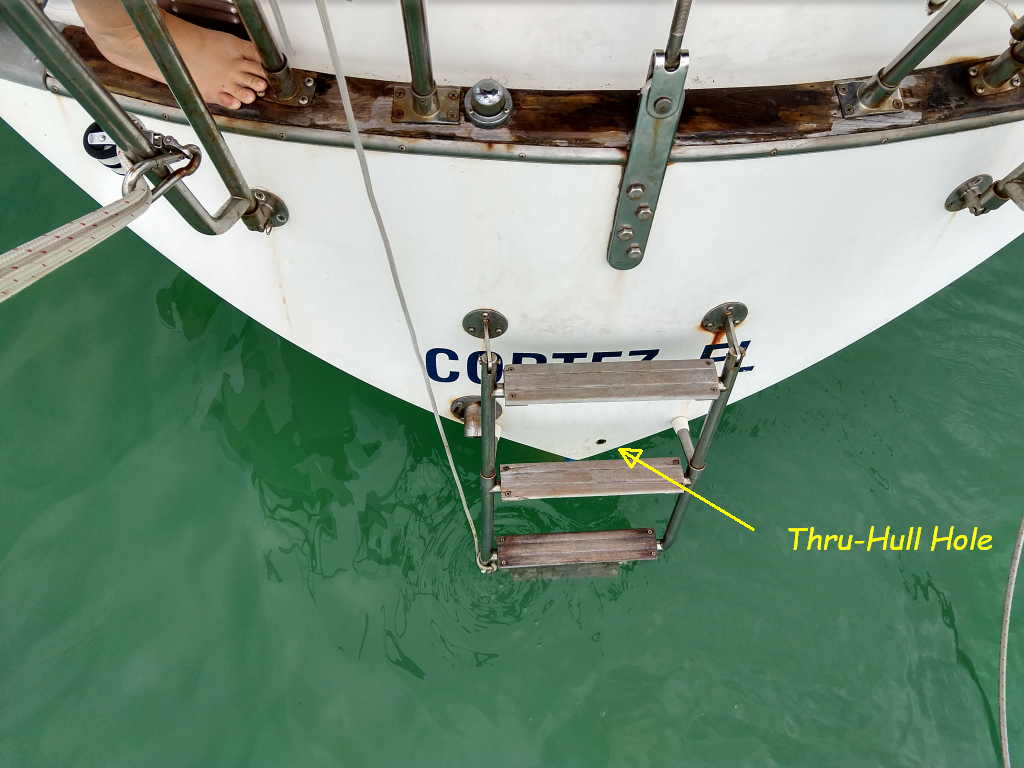
Then I reattached the propane locker vent hose with hose clamps, and “Voila”….cross an item off the to do list!
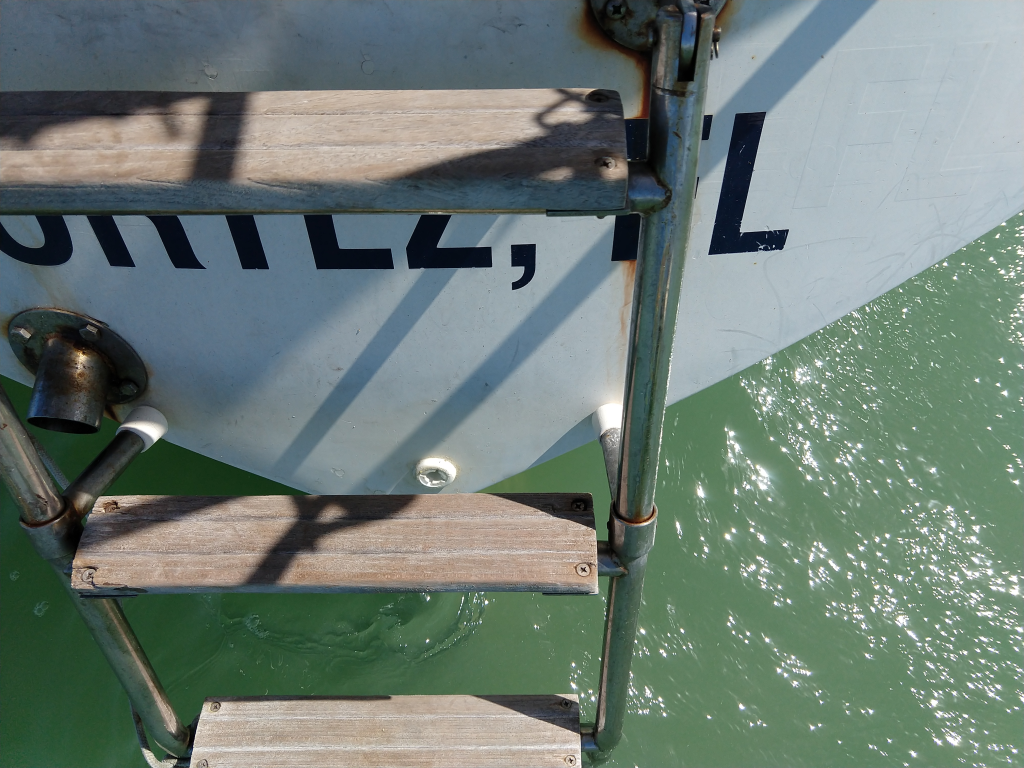
The other thing we noticed on the over night passage was that the tiny light used to illuminate our ship’s compass wasn’t functioning. The nice thing about that light is that you don’t have to flip on a flash light and temporarily ruin your night vision to glance at your course heading. I figured the bulb had just burned out, and I had a spare, so I removed some trim on the compass and got to the bulb and wiring. Hmmmm, no simple connections on this tiny little bad boy. It’s tiny wires are soldered on. Not too difficult a job, but not the simple replacement I was hoping for.
So, since I wasn’t 100% sure that the problem was a burned out bulb (I wasn’t registering power on my volt meter at the bulb but wasn’t 100% sure of that either), I decided to trouble shoot the wiring before breaking out my propane soldering torch and soldering wire. Into a cramped, contorted cave of back pain I climbed.
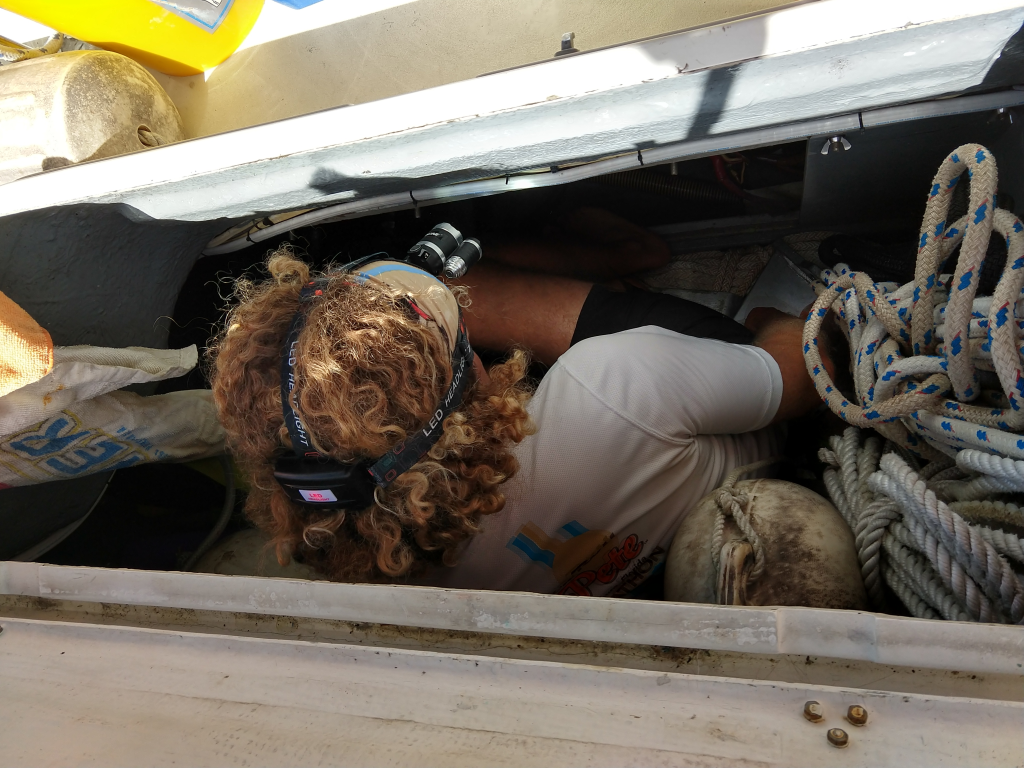
A little further in and some more investigation, and I found it. A few months before I found a ground wire that didn’t seem to be doing anything, so I removed it. The electrical work of 4 previous owners of Holiday through the years has left many a jumbled rats nest of wires, and eventually cleaning all that up is something I try to do little by little.
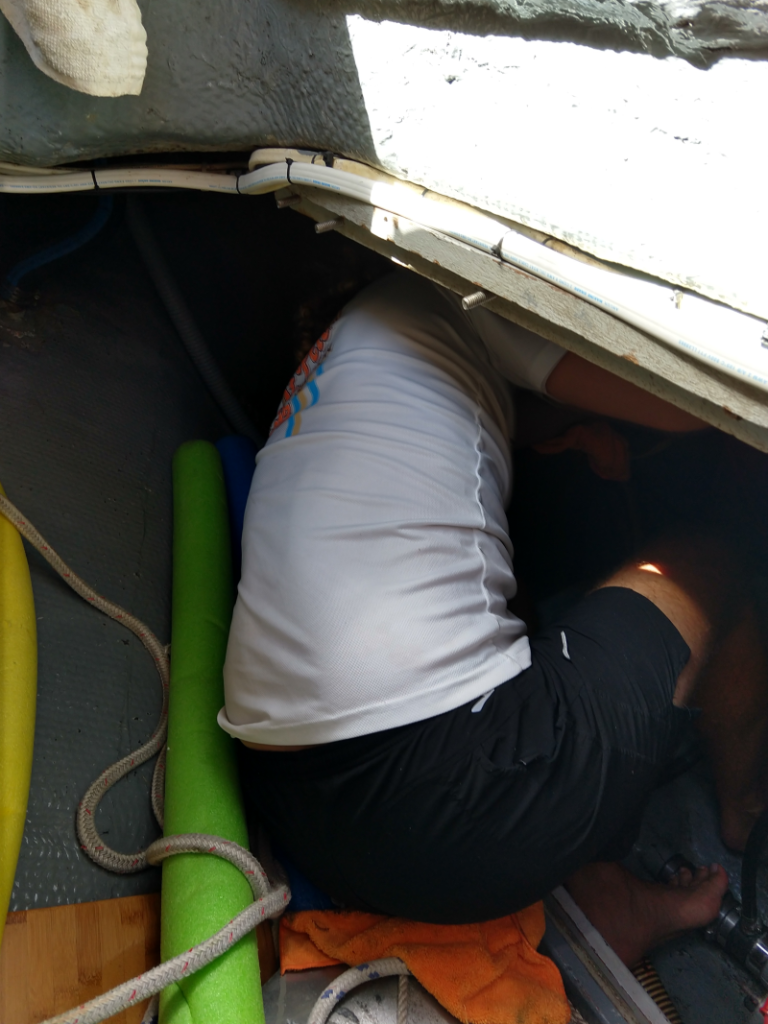
Well, it turns out that ground wire lead from a buss bar here and a connection there to eventually a bus bar with only the ground of the compass light attached to it. Once I ran a wire from the common ground back to that buss bar, boom went the dynamite, and light was restored.
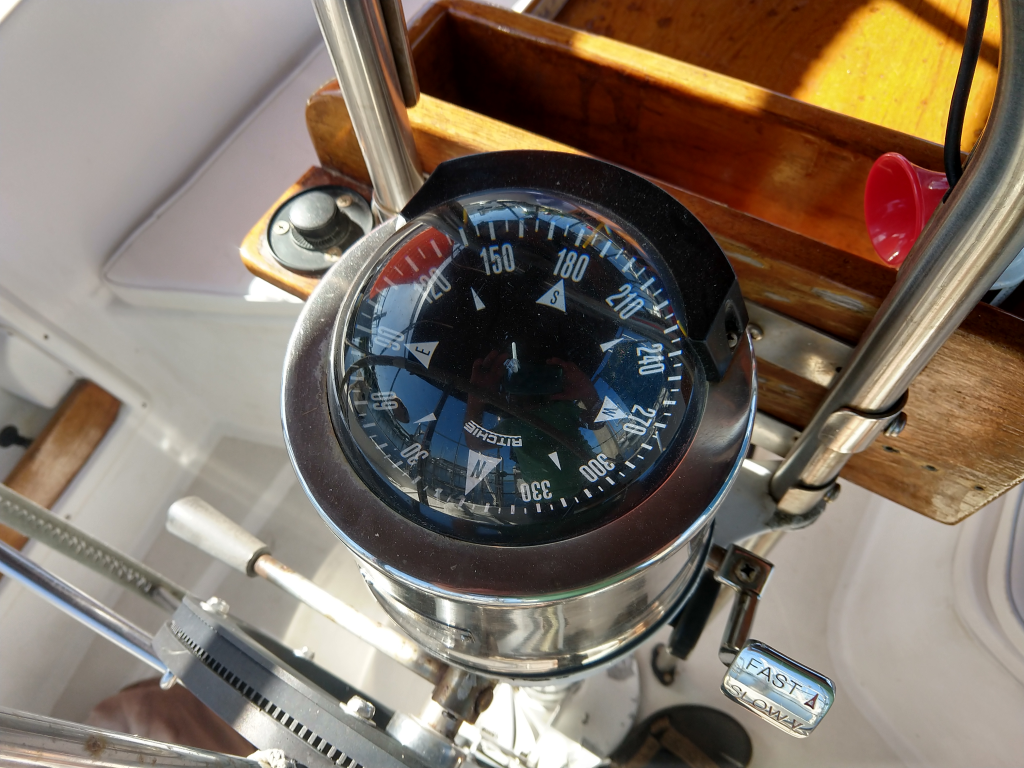
Next on the list was a new problem. During our transmissions on the VHF radio in the mornings on the Boot Key Cruiser’s Net, we would often have people tell us that we could be heard but there was a “wicked hum”. We did a little testing between our hand held and our mounted unit and definitely heard what they were talking about.
Attached to a mooring in Boot Key Harbor, this “hum” was a small annoyance, but the VHF is also an extremely important piece of safety equipment. While underway, it is how you call for help in an emergency. The further offshore you go (out of cell phone range), the more important it becomes, and you definitely want it to be working at full capacity with full power and the best clarity.
After some Googling, I became convinced that some sort of electrical interference was causing the noise. I started checking the antenna wiring and all the electrical connections for the radio and anything else on the same buss bar with the radio.

I spent days experimenting with different combinations of things on or off or connected or disconnected.

Joke was on me. Turned out that my VHF microphone was old and was causing the problem itself. Lol. Must remember to check the simplest explanation first…
Instead of trying to repair my old radio, we took the opportunity to upgrade to a new unit with a built in GPS like I had been wanting. With this unit, a push of a simple button will send out a digital distress signal to the coast guard and all boats within range that contains our exact GPS coordinates. It also displays the coordinates on the screen and the remote I have at the helm for quick, easy checking or relaying. Lastly, it is compatible with an AIS transceiver if we ever decide to upgrade from our receive only AIS model.

Holiday has….count ’em…..11 winches! Winches are great. Winches are necessary for moving the lines of the sails that contain huge loads sometimes that a human would be powerless to move without them. Winches are also very expensive. $1000 a piece on the average of ours is probably not an overstatement. Guess what happens if you never service them. You learn that the cliche of B.O.A.T. (break out another thousand) is much more than cliche.
With that in mind, it was time to start the maintenance on ours. We had them serviced by a yard during our initial purchase overhaul and had never done it ourselves. That was quite a few years ago and guidance is to do it yearly (although that is probably a bit over zealous).
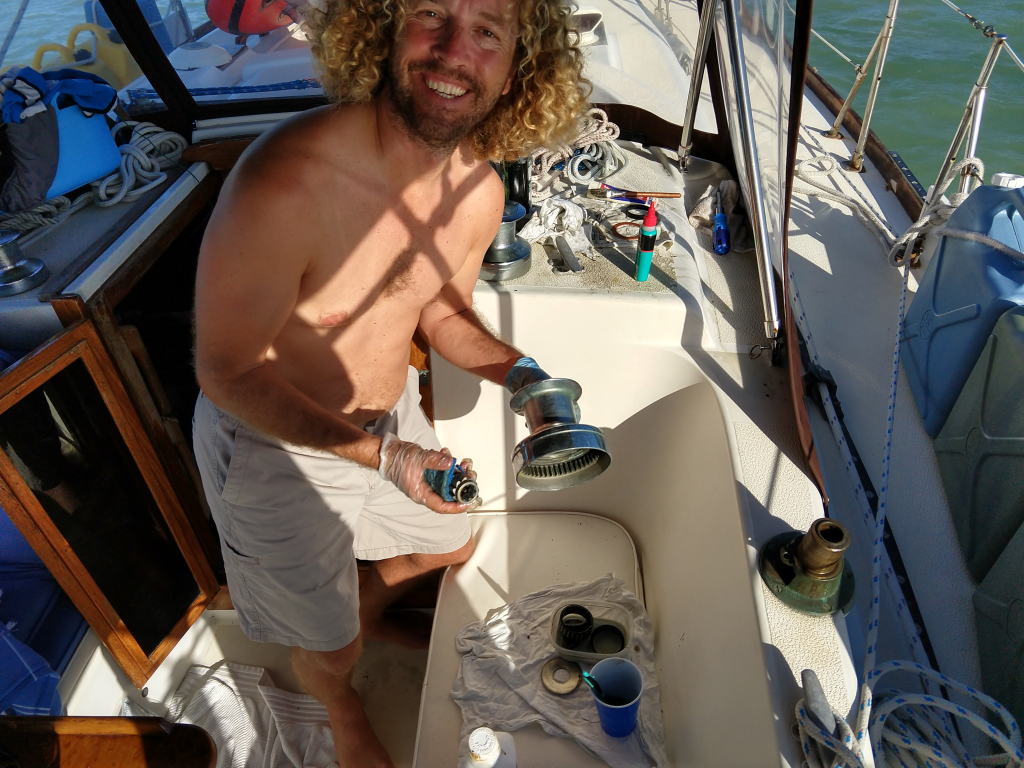
Turns out it’s pretty easy, and after the first one, there really aren’t any surprises with all the rest. Ours seemed to all be in fine shape, so I’ll probably wait a couple years or so before doing them again.
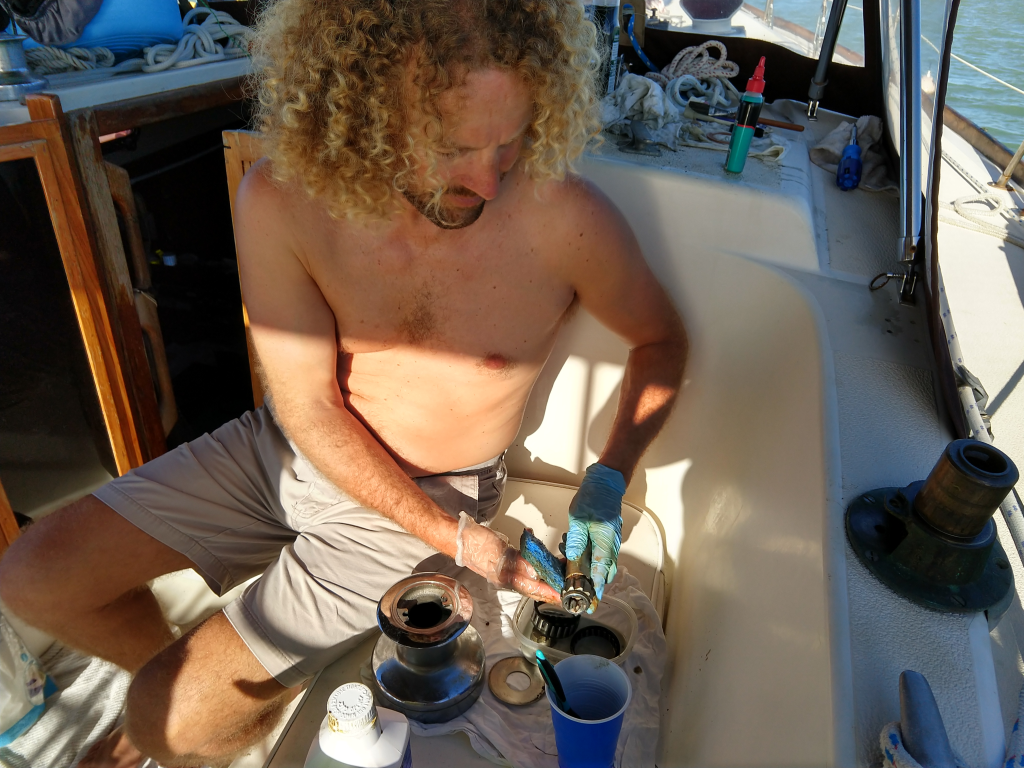
Only every once in a while did I come upon parts that were stuck and had to break out the ol’ PB Blaster and a hammer 🙂
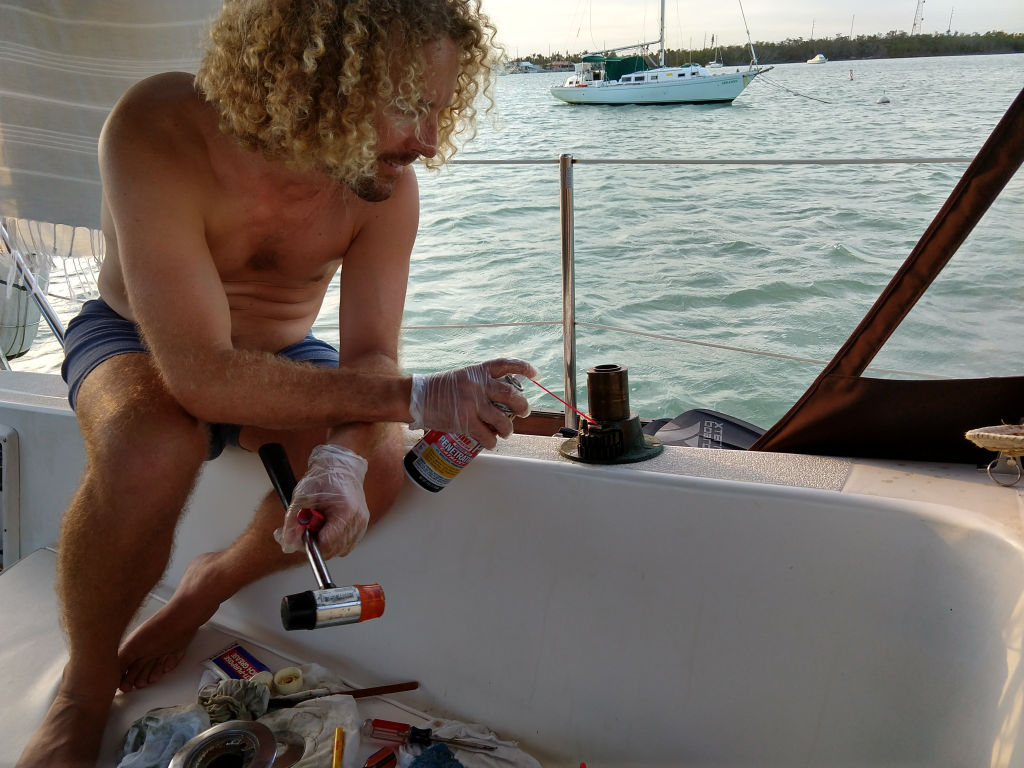
Next, I installed the Mantus anchor swivel we had bought a few months before. I’m pretty excited about this guy as we’ll be using it a lot while anchoring in higher current and tide areas as we go up the ICW this summer. Without the swivel when we have stayed for longer periods at anchor, over time the anchor chain gets twisted as Holiday swings back and forth in a circle with the rising and falling of tides. Then the windlass that pulls in the chain gets hung up during retrieval since the chain links are twisted and bunched up.
With this swivel, that won’t happen anymore. And Mantus has also designed it so that it is not the weakest link in your chain (they claim it’s the strongest link) as was the problem with previous swivels.
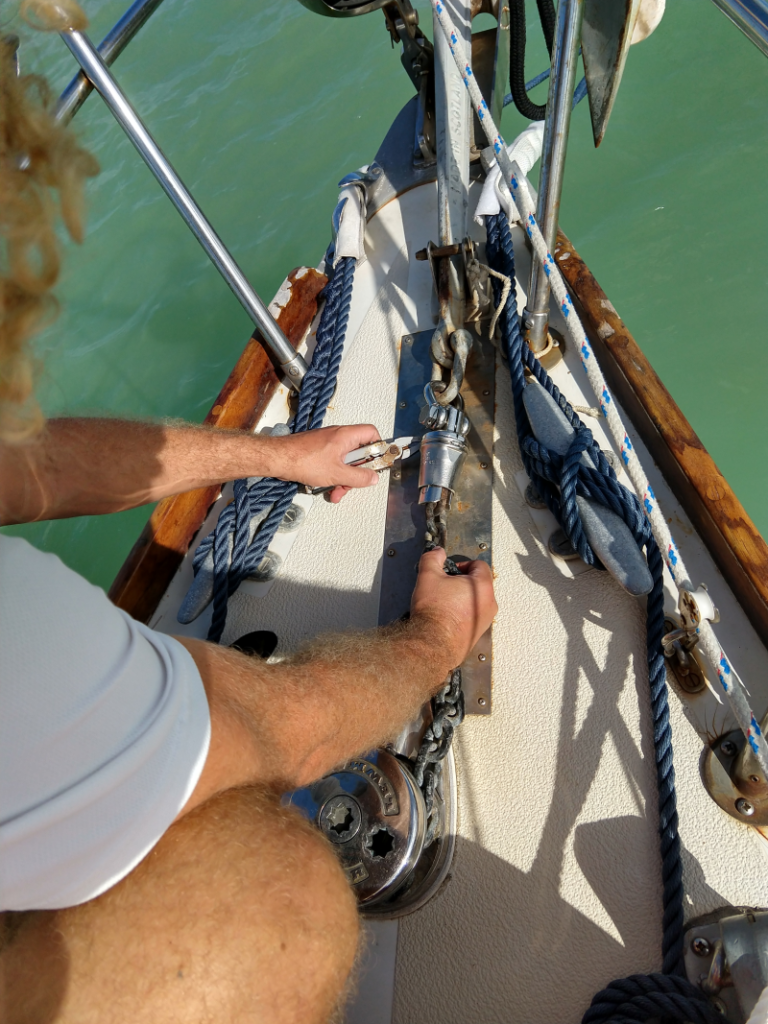
Lastly, not only did I work on Holiday during our time at BKH, I also helped a neighbor that needed to remove his old broken diesel in advance of repowering his sailboat with a new one. This may be an easier process tied to a dock in a boat yard with cranes and what not, but we were going to attempt it with a few other guys while on the mooring ball. Keep in mind these diesels in the 50 hp range weigh well over 500 lbs!
One neat thing about a sailboat is that the same system that holds and controls the powerful forces involved with the sails (mast, boom, lines, blocks, and winches), can also be used to lift and manage very heavy objects on board and around the boat.
With the engine disconnected from all it’s mounts and components, we hoisted it with chains and lifting blocks and inched it out of the engine room to the companion way.
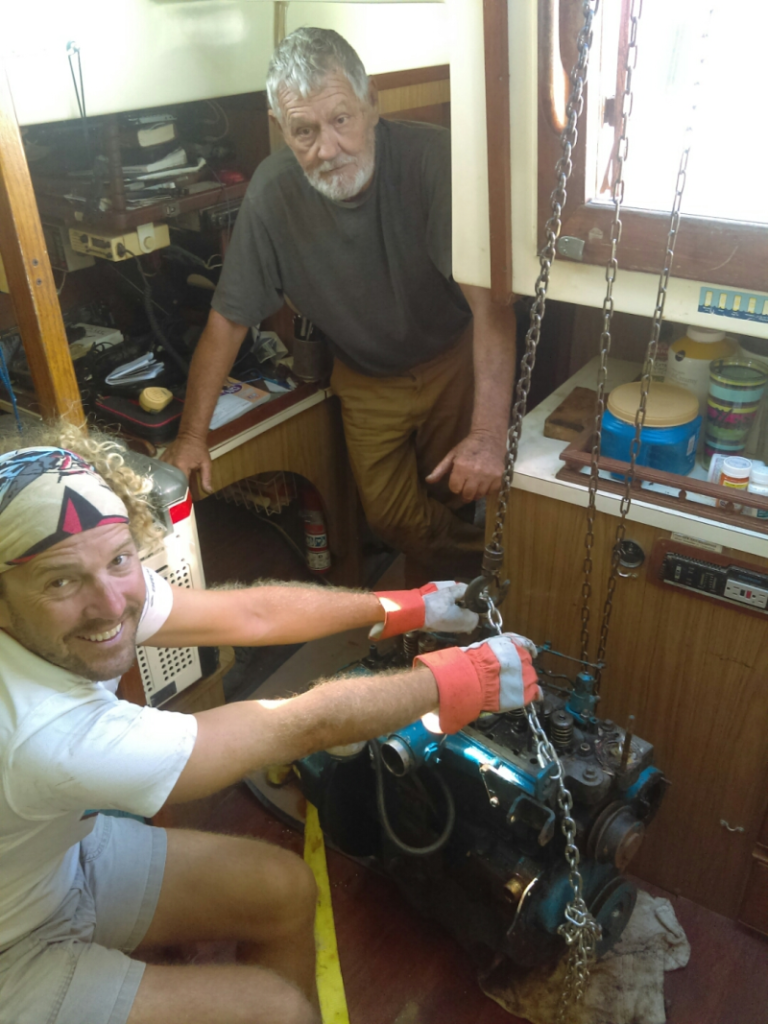
After that we used the boom to lift the beast the four feet or so into the cockpit. Even though it was securely attached, you better believe I was taking care to not have my toes or anything underneath the lifted bone crusher.
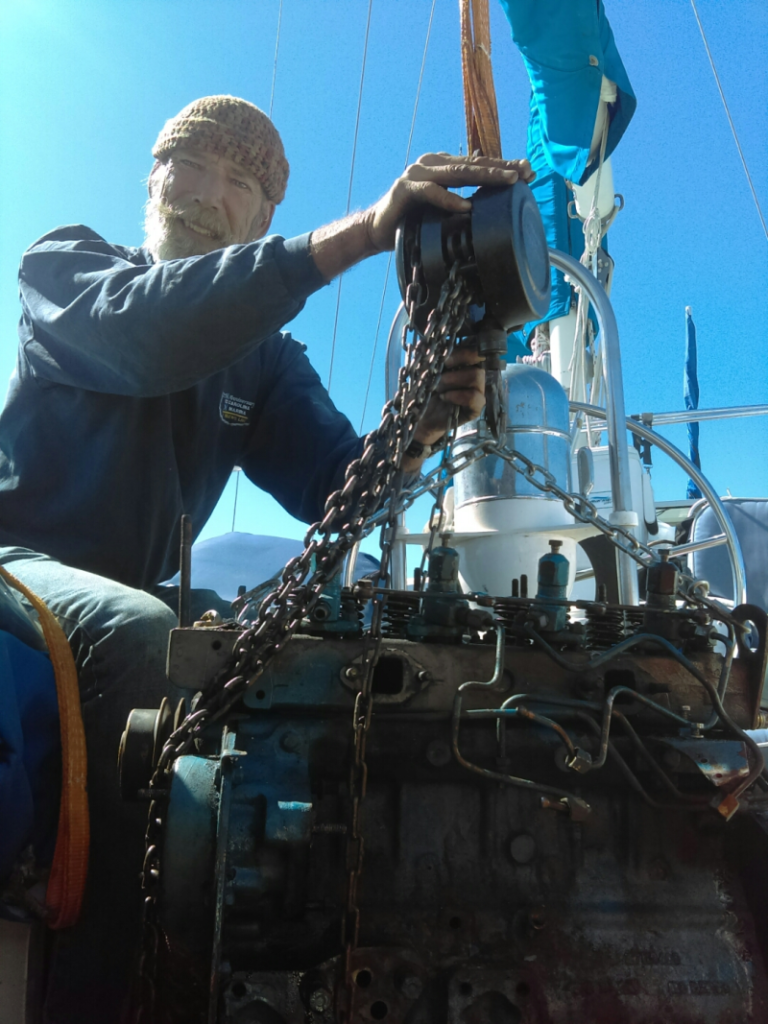
From there, we hoisted it high enough to swing above the cockpit and life lines and out over the water where another friend on a tow boat drove underneath to take the engine to shore.
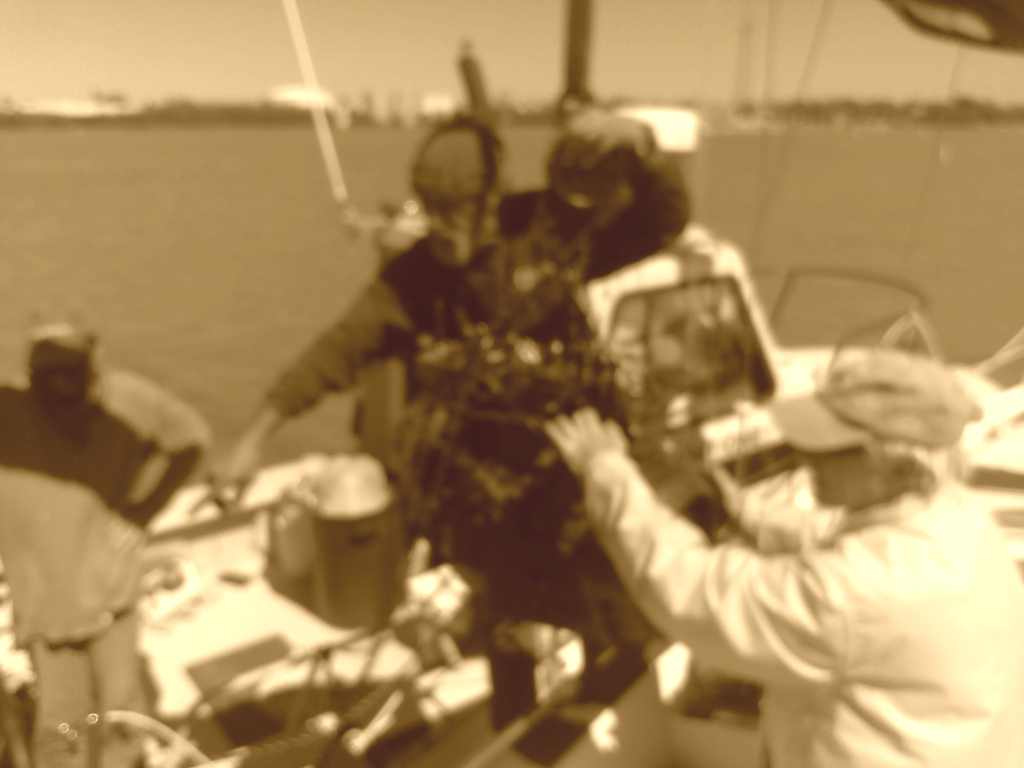
It was pretty amazing to have gotten this heavy engine this far with no electrical power or motor driven equipment.
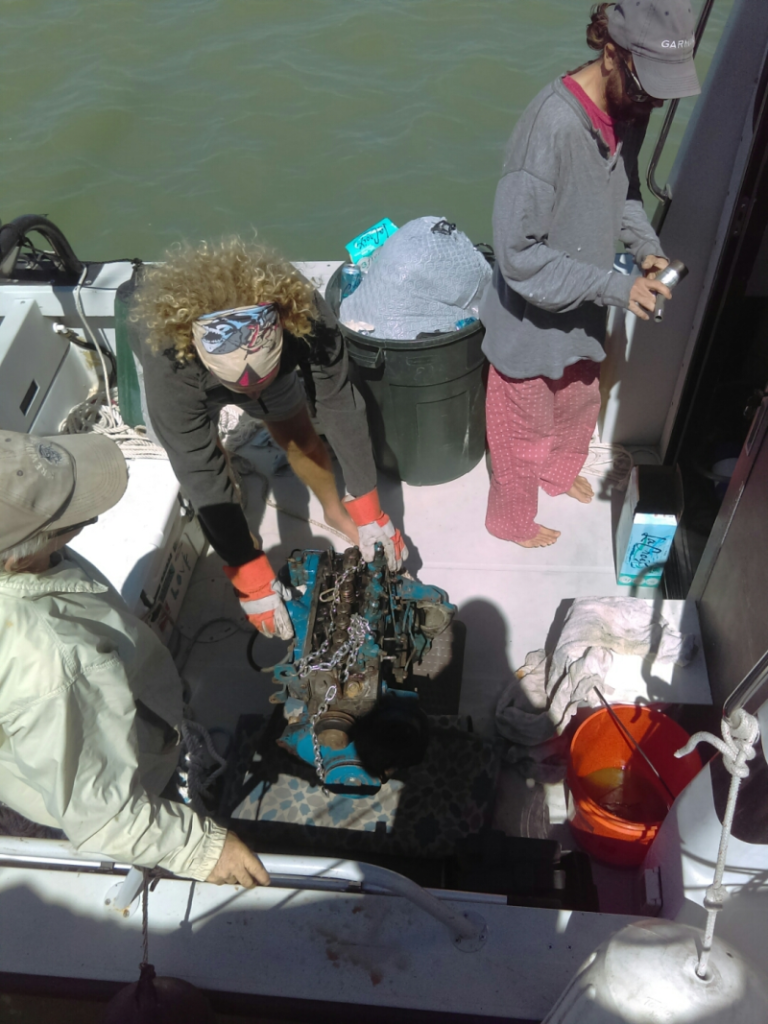
Once we got to the dock, one more crane for lifting…
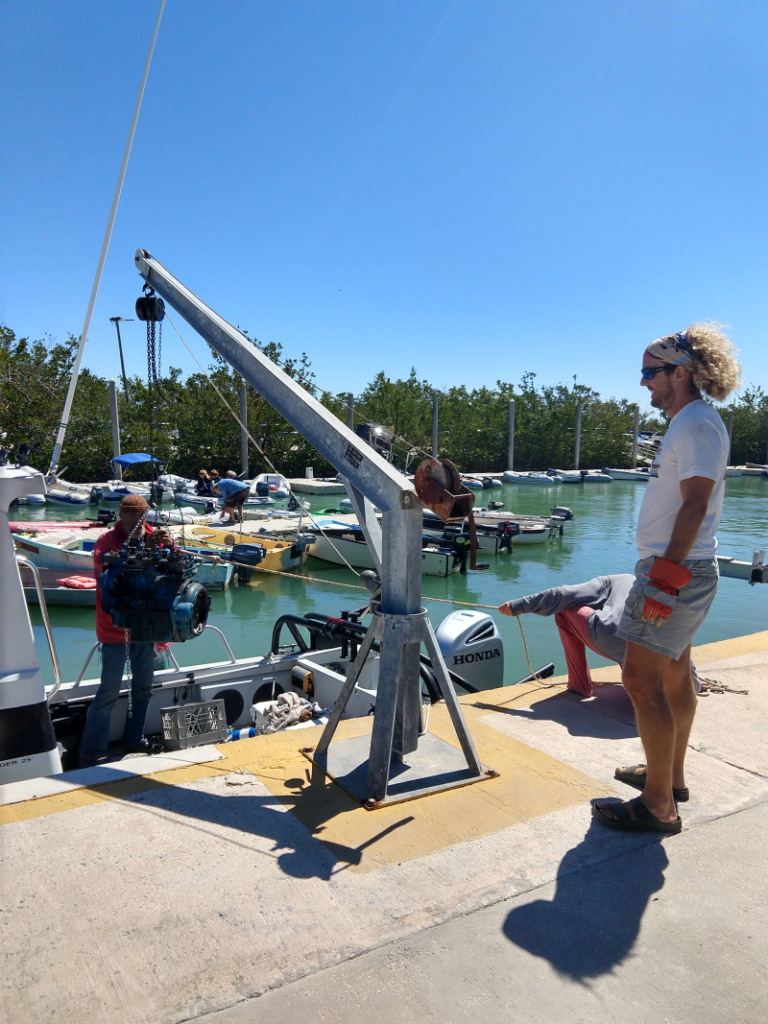
and the job was done!
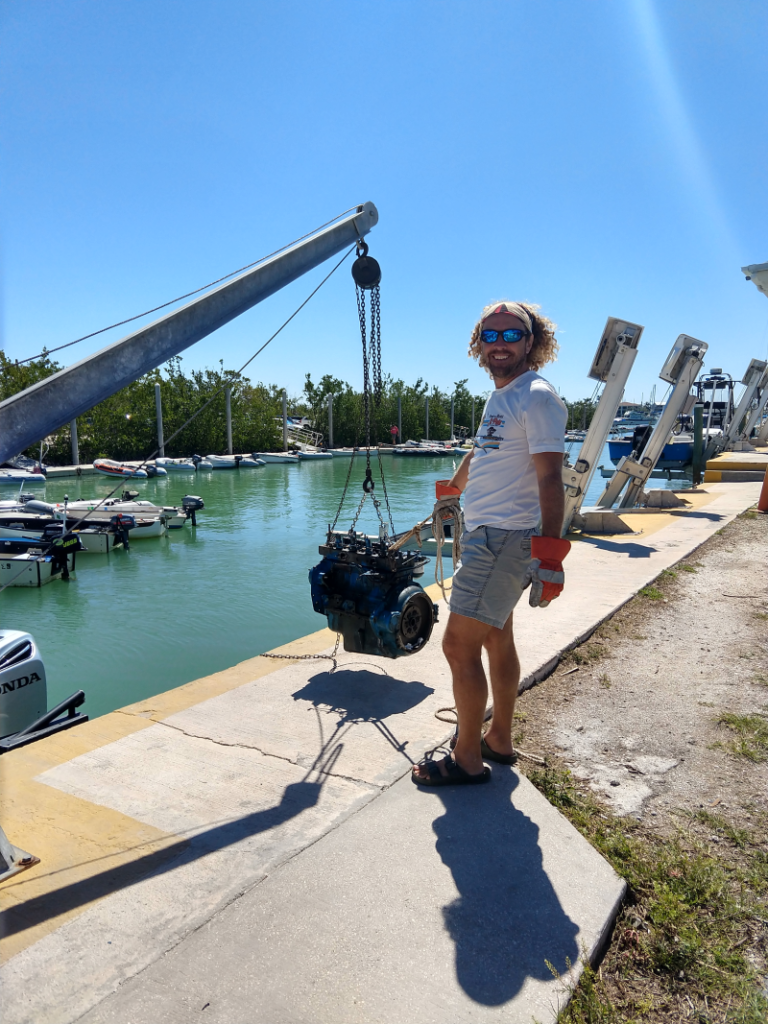
What a cool experience! I learned a lot and had a fun time hanging out with and helping neighbors in the mooring field.
There were quite a few more boat chores completed during our stay and just as many that we didn’t get to and are still working on. It can be frustrating at times, and there is usually a point in every boat job where I think “I don’t think I’m going to be able to do this myself.” But, in the end it always works out somehow. And, with every chore completed, we gain more experience making the next task that much easier.

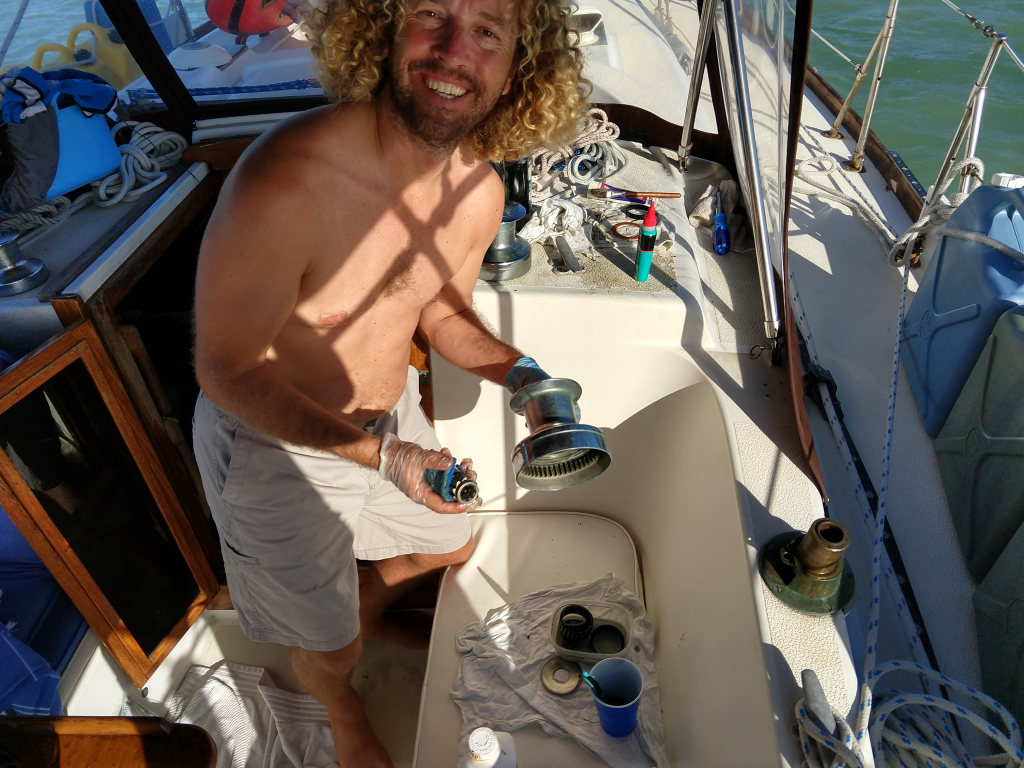
Mary W Duncan
May 15, 2018 at 10:52 pmI like the camaraderie among cruisers who always help each other out. Also, I like that you replaced the old VHS radio with one that has a GPS built in so you can call the coast guard with a touch of one button. I’m sure Ms. Rita likes that too.